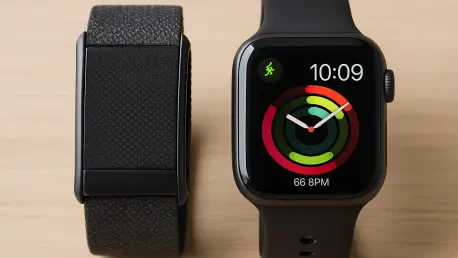In an era where wearable technology has become a cornerstone of health and fitness, millions of users worldwide are tracking every heartbeat, step, and sleep cycle with devices strapped to their wrists. Imagine a scenario where choosing the right wearable could mean the difference between achieving peak athletic performance and merely scratching the surface of personal wellness goals. This pressing decision brings two heavyweight contenders into the spotlight: the Whoop MG, a fitness tracker designed for precision and recovery, and the Apple Watch, a versatile smartwatch that blends lifestyle with health monitoring. Both devices dominate their respective niches, but their approaches to wearable tech differ significantly. This comparison delves into their features, design, performance, and value to help clarify which device might best suit specific needs and lifestyles.
Key Feature Comparison
Fitness and Health Tracking Capabilities
The core strength of the Whoop MG lies in its specialized focus on recovery and performance optimization. This screenless tracker offers advanced metrics like strain levels, sleep analysis, and recovery percentages, providing athletes with actionable insights to fine-tune their routines. Additionally, with the top-tier subscription, it includes medical-grade features such as ECG for detecting heart irregularities and estimated blood pressure monitoring, setting it apart in depth and precision for serious fitness enthusiasts.
In contrast, the Apple Watch presents a broader spectrum of health and fitness tracking tools suitable for a wider audience. Equipped with built-in GPS, heart rate monitoring, blood oxygen sensing, and ECG capabilities across various models, it caters to both casual users and fitness buffs. Its integration with a vast ecosystem of fitness apps further enhances its utility, allowing seamless data sharing and personalized workout plans, often matching or exceeding the accuracy of dedicated trackers in user tests.
While both devices excel in delivering health data, their focus diverges significantly. The Whoop MG prioritizes in-depth recovery analytics tailored for elite performers, whereas the Apple Watch balances fitness with everyday health needs, offering a more holistic approach. Users seeking granular details on strain and rest will lean toward the former, while those desiring comprehensive tracking with lifestyle integration will find the latter more appealing.
Design and User Experience
Design philosophy plays a pivotal role in how these devices fit into daily life. The Whoop MG embraces a minimalist, distraction-free approach with its screenless form factor, relying entirely on a companion app for data interaction. Its lightweight build ensures comfort during constant wear, though hardware issues, such as a problematic stainless-steel clasp that often detaches, can frustrate users and detract from an otherwise sleek experience.
On the other hand, the Apple Watch boasts a polished, interactive design with a vibrant display and customizable watch faces that cater to personal style. Its seamless integration with iOS devices creates a fluid user experience, from receiving notifications to controlling music directly from the wrist. This interactivity, combined with a premium build, makes it a natural extension of daily tech use, though its bulkier design might not suit everyone for 24/7 wear.
Ultimately, the design choice hinges on user preference for interaction versus simplicity. Those who value a no-frills, app-driven interface may appreciate the Whoop MG despite its hardware quirks, while individuals seeking an all-in-one device with visual feedback and intuitive controls are likely to favor the Apple Watch for both comfort and functionality in varied scenarios.
Battery Life and Hardware Performance
When it comes to staying powered up, the Whoop MG stands out with an impressive battery life of around nine days on a single charge, complemented by a convenient on-wrist charging system that minimizes downtime. This endurance makes it ideal for continuous wear, especially for users focused on round-the-clock tracking. However, the absence of built-in GPS limits its scope for activities like running or cycling where location data is crucial.
Conversely, the Apple Watch typically offers a shorter battery life, ranging from 18 to 36 hours depending on the model and usage, necessitating more frequent charging. Yet, its hardware capabilities are far more extensive, featuring built-in GPS, optional cellular connectivity, and a responsive display that supports a range of functions beyond fitness tracking. These features cater to users who prioritize versatility over extended battery duration.
Balancing these aspects reveals a trade-off between longevity and functionality. The Whoop MG suits those who value uninterrupted wear and minimal maintenance, while the Apple Watch appeals to users who need a multifaceted device, even if it requires more regular charging to keep up with demanding lifestyles.
Pricing, Accessibility, and Limitations
Cost structures for these devices present stark contrasts that influence their accessibility. The Whoop MG operates on a subscription-based model, with the premium Whoop Life plan costing approximately $359 annually, which includes access to medical-grade features. Without this ongoing payment, the device becomes unusable, posing a significant barrier for budget-conscious consumers and limiting its appeal to affluent athletes or dedicated fitness enthusiasts.
The Apple Watch, by contrast, follows a one-time purchase model with prices varying by model, such as the Series 9 or Ultra 2, starting at more affordable entry points for basic versions. Optional subscriptions like Apple Fitness+ add value but aren’t mandatory for core functionality. This structure, combined with its compatibility across a wide range of budgets and needs, makes it accessible to a broader demographic seeking a reliable smartwatch.
Limitations further shape the decision-making process. The Whoop MG lacks GPS and can feel intrusive with frequent app notifications about lifestyle adjustments, while the Apple Watch’s shorter battery life and dependency on an iPhone for full features may deter some users. Financial constraints, technical dependencies, and lifestyle compatibility thus play critical roles in determining which device aligns better with individual circumstances and long-term usability.
Final Verdict and Recommendations
Summarizing the critical points of this comparison, the Whoop MG and Apple Watch cater to distinct user bases through their unique strengths. The former excels in niche fitness tracking with unparalleled recovery metrics and extended battery life, yet its high subscription cost and hardware flaws narrow its audience. The latter offers versatility with robust health features, seamless design, and broader appeal, though it falls short on battery endurance and requires iOS integration.
A balanced assessment highlights that the Whoop MG serves as a specialized tool for dedicated athletes or individuals obsessed with performance optimization, unconcerned by recurring fees. Meanwhile, the Apple Watch stands as a comprehensive lifestyle companion, ideal for a wider audience seeking a blend of fitness tracking and daily utility. Each device has clear advantages, but also notable drawbacks that must be weighed against personal priorities.
Looking back, the exploration of these wearables underscored the importance of aligning technology with specific goals. Moving forward, potential buyers should consider creating a shortlist of must-have features—whether deep recovery insights or all-purpose functionality—and test devices where possible to ensure comfort and compatibility. Additionally, keeping an eye on emerging competitors in the wearable market could reveal alternatives that bridge the gaps left by both contenders, ensuring a choice that evolves with future needs.









